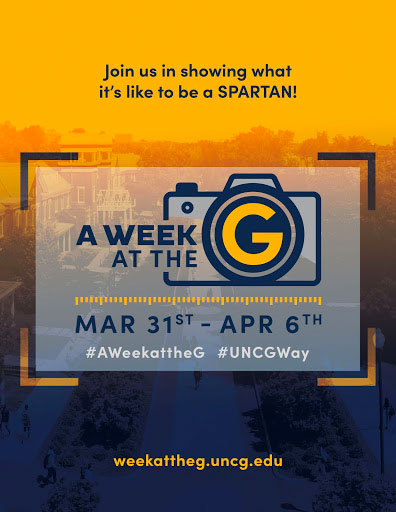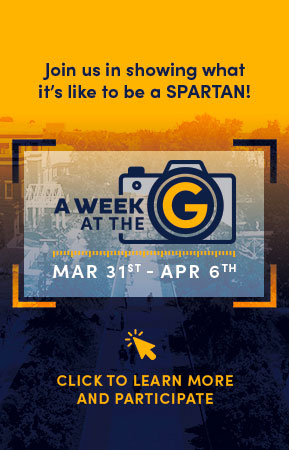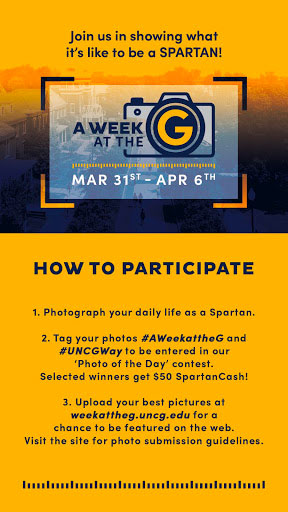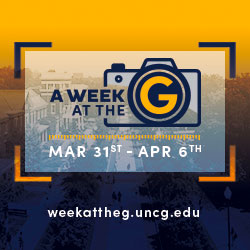Best Practices
SIZING FOR VARIOUS PLATFORMS
Communicating the same message across various platforms requires flexibility. Some modes of communication provide ample space to communicate in-depth details regarding an event or call-to-action. Other modes of communication are very limited. Thus, design, content, and imagery need to be adapted to best meet the abilities of the mode of communication.
For example, campus video monitors provide ample space in a horizontal layout. But that same message on Instagram Stories must be redesigned for a vertical layout. Flyers, digital advertisements, and website banners have less space.
See how A Week at the G promotions changed by mode of communication:






GENERAL TIPS
Regardless of the mode of communication, there are some core best practices when promoting an event or call-to-action.
- Include date, time, and location.
- The Editorial Guidance Section of the University’s brand guide provides direction on naming structure, how to list room and building information, and more.
- Use an engaging image or graphic.
- Find and download University images by using your email and password to log into Merlin, the University’s digital asset management system.
- If an image is not applicable, work with a graphic artist to develop a high-quality graphic. Do not use clip art.
- Include a University logo and sponsor logos.
- A department or unit logo signifies the event or call-to-action is connected to and supported by the University – and the participant knows it will be a great event!
- Provide recognition to your off-campus sponsors and partners by including their logos in the design. You may also recognize them in written copy describing the event and/or during formal announcements or signage at the event.
- When multiple units or departments are sponsoring a singular event, use the highest-level logo. For example, if biology, English, and women’s and gender studies are sponsoring an event, the College of Arts and Sciences logo should be used. Another example? If more than one college is sponsoring an event, the University’s main logo should be used. Recognition of the individual programs, departments, or units can be executed in the written copy or at the event itself through formal announcements or signage. Including all unit, department, or college logos limits the space available to communicate the details of the event in which you are encouraging participation and can disengage the reader.
- Only University logos (college, department, or unit level logos) provided by University Communications should be included. Any logos designed prior to August 2018 are retired from use.
- Provide a way for your audience to engage and learn more.
- For a flyer, provide a web page address or an email address where more information can be obtained.
- For a digital ad, provide the vendor with a web page address where users who click on the ad can be transported. GoLinks, provided by the University, can shorten a long URL and help you track the click-through rates.
- Customize the artwork size for the mode of communication.
- Flyers and brochures do not replicate well on social media. Resize the graphics for the method in which they will be displayed.
- Flyers: 8 ½ inches x 11 inches
- Video Screens on Campus: 1920 pixels x 1080 pixels
- Twitter: 1920 pixels x 1080 pixels, or 1024 pixels x 512 pixels
- Facebook: 1920 pixels x 1080 pixels, or 1200 pixels x 628 pixels
- Instagram: 1080 pixels x 1080 pixels, or 1080 pixels x 1920 pixels (Stories)
- For social media promotion, consider including an event hashtag and relevant account tags in the posts, and GoLink on the graphics.
- Visit the UNCG social media resources page for a list of commonly used UNCG hashtags, and brand and style guidelines.
- QR codes are difficult to use on social media and should be reserved for print publications and digital displays in physical locations.
TIPS FOR BROCHURES
The goal of a brochure is to provide introductory information about a program or event that your target audience can keep and refer to at their convenience. For example, a potential student may pick up an academic program brochure at a recruitment fair and later refer to it seeking contact information.
- Keep content brief but informative.
- Use engaging images or graphics
- Use a University logo. Logos (University, department, unit, and program logos) created prior to August 2018 are retired from use.
- Use the University’s brand colors, fonts, tagline, and messaging.
- In the content, explain/incorporate:
- what service/expertise the program/office provides;
- what benefits will the target audience receive;
- how this program/service at UNCG is unique – differentiate from the competition;
- actions the target audience needs to take in order to participate, e.g., application, payment;
- clearly defined deadlines, if applicable;
- the flexible tagline, i.e. Find your ____ here.
- Clearly identify contact information.
- If the preference is for email communication, do not list a phone number.
- Provide a website address where more information can be accessed.
- Share social media handles or hashtags, if applicable.
BROCHURE TEMPLATES (SAMPLES)
To access the InDesign files for template brochures, use your UNCG credentials to download the sample pdf brochures and InDesign files.
BROCHURE TEMPLATE 1 (SPARTAN STARTUP BROCHURE):


BROCHURE TEMPLATE 2 (ACADEMIC SUCCESS COACHING BROCHURE)

BROCHURE TEMPLATE 3 (HORIZONTAL BROCHURE)

BROCHURE TEMPLATE 4 (VERTICAL BROCHURE):
